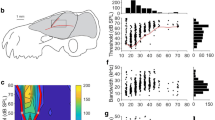Abstract
Bats are the only mammals capable of true powered flight. The bat wing exhibits specializations, allowing these animals to perform complicated flight maneuvers like landing upside-down, and hovering. The wing membrane contains various tactile receptors, including hair-associated Merkel receptors that might be involved in stabilizing bat flight. Here, we studied the neuronal representation of the wing membrane in the primary somatosensory cortex (S1) of the anesthetized Big Brown Bat, Eptesicus fuscus, using tactile stimulation with calibrated monofilaments (von Frey hairs) while recording from multi-neuron clusters. We also measured cortical response thresholds to tactile stimulation of the wings.The body surface is mapped topographically across the surface of S1, with the head, foot, and wing being overrepresented. The orientation of the wing representation is rotated compared to the hand representaion of terrestrial mammals, confirming results from other bat species. Although different wing membrane parts derive embryologically from different body parts, including the flank (plagiopatagium), the tactile sensitivity of the entire flight membrane (0.2–1.2 mN) is remarkably close or even higher (dactylopatagium) than the average tactile sensitivity of the human fingertip.




Similar content being viewed by others
Abbreviations
- D1–5:
-
Digit 1–5
- IFM:
-
Interfemoral membrane
- S1:
-
Primary somatosensory cortex
References
Adrian ED (1941) Afferent discharges to the cerebral cortex from peripheral sense organs. J Physiol 100:159–191
Calford MB, Graydon ML, Huerta MF, Kaas JH, Pettigrew JD (1985) A variant of the mammalian somatotopic map in a bat. Nature 313:477–479
Catania KC, Kaas JH (1997) Somatosensory fovea in the star-nosed mole: behavioral use of the star in relation to innervation patterns and cortical representation. J Comp Neurol 387:215–233
Catania KC, Remple MS (2002) Somatosensory cortex dominated by the representation of teeth in the naked mole-rat brain. Proc Natl Acad Sci 99:5692–5697
Covey E (unpublished) A stereotaxic brain atlas of the Big Brown Bat, Eptesicus fuscus. University of Washington
Cretekos CJ, Weatherbee SD, Chen CH, Badwaik NK, Niswander L, Behringer RR, Rasweiler JJ (2005) Embryonic staging system for the short-tailed fruit bat, Carollia perspicillata, a model organism for the mammalian order Chiroptera, based upon timed pregnancies in captive-bred animals. Dev Dyn 233:721–738
Hedenström A, Johansson LC, Wolf M, von Busse R, Winter Y, Spedding GR (2007) Bat flight generates complex aerodynamic tracks. Science 316:894–897
Johansson RS, Vallbo ÅB, Westling G (1980) Thresholds of mechanosensitive afferents in the human hand as measured with von Frey hairs. Brain Res 84:343–351
Kaas JH (1983) What, if anything, is SI? Organization of first somatosensory area of cortex. Physiol Rev 63:206–231
Krubitzer LA, Calford MB (1992) Five topographically organized fields in the somatosensory cortex of the flying fox: microelectrode maps, myeloarchitecture, and cortical modules. J Comp Neurol 317:1–30
Kurta A, Baker RH (1990) Eptesicus fuscus. Mammalian Species 356:1–10
Manger PR, Rosa MG, Collins R (2001) Somatotopic organization and cortical projections of the ventrobasal complex of the flying fox: an “inverted” wing representation in the thalamus. Somatosens Mot Res 18:19–30
Marshall WH, Woolsey CN, Bard P (1938) Cortical representation of tactile sensibility as indicated by cortical potentials. Science 85:388–390
Martin RL (1993) Representation of the body surface in the gracile, cuneate, and spinal trigeminal nuclei of the little red flying fox (Pteropus scapulatus). J Comp Neurol 335:334–342
Muijres FT, Johansson LC, Barfield R, Wolf M, Spedding GR, Hedenström A (2008) Leading-edge vortex improves lift in slow-flying bats. Science 319:1250–1253
Nelson RJ, Sur M, Felleman DJ, Kaas JH (1980) Representations of the body surface in postcentral parietal cortex of Macaca fascicularis. J Comp Neurol 192:611–643
Norberg UM, Rayner JMV (1987) Ecological morphology and flight in bats (Mammalia; Chiroptera): wing adaptations, flight performance, foraging strategy and echolocation. Phil Trans Royal Soc Lond 316:335–427
Petersen CCH (2007) The functional organization of the barrel cortex. Neuron 56:339–355
Studier EH (1972) Some physical properties of the wing membrane of bats. J Mammal 53:623–625
Swartz SM, Groves MS, Kim HD, Walsh WR (1996) Mechanical properties of bat wing membrane skin. J Zool 239:357–378
Teeling EC, Springer MS, Madsen O, Bates P, O’Brien SJ, Murphy WJ (2005) A molecular phylogeny for bats illuminates biogeography and the fossil record. Science 307:580–584
Weatherbee SD, Behringer RR, Rasweiler JJ, Niswander LA (2006) Interdigital webbing retention in bat wings illustrates genetic changes underlying amniote limb diversification. Proc Natl Acad Sci USA 103:15103–15107
Winter Y, von Helversen O (1998) The energy cost of flight: do small bats fly more cheaply than birds? J Comp Physiol B 168:105–111
Wise LZ, Pettigrew JD, Calford MB (1986) Somatosensory cortical representation in the Australian ghost bat, Macroderma gigas. J Comp Neurol 248:257–262
Woolsey TA, Van der Loos HV (1970) The structural organization of layer IV in the somatosensory region (SI) of mouse cerebral cortex. The description of a cortical field composed of discrete cytoarchitectonic units. Brain Res 17:205–242
Zook JM (2005) The neuroethology of touch in bats: cutaneous receptors of the wing. Soc Neurosci Abstr 78:21
Zook JM (2006) Somatosensory adaptations of flying mammals. In: Kaas JH (ed) Evolution of Nervous Systems, vol 3. Academic Press, Oxford, pp 215–226
Zook JM, Fowler BC (1986) A specialized mechanosensory array of the bat wing. Myotis 23–24:31–36
Acknowledgments
This study was sponsored by Air Force Office of Scientific Research (AFOSR), MURI grant “Bio-inspired flight for micro-air vehicles”. Data collected under research protocol, “Somatosensory signaling for flight control,” approved by the University of Maryland Institutional Animal Care and Use Committee. We thank John Zook for his advice in planning these studies.
Author information
Authors and Affiliations
Corresponding author
Rights and permissions
About this article
Cite this article
Chadha, M., Moss, C.F. & Sterbing-D’Angelo, S.J. Organization of the primary somatosensory cortex and wing representation in the Big Brown Bat, Eptesicus fuscus . J Comp Physiol A 197, 89–96 (2011). https://doi.org/10.1007/s00359-010-0590-9
Received:
Revised:
Accepted:
Published:
Issue Date:
DOI: https://doi.org/10.1007/s00359-010-0590-9




